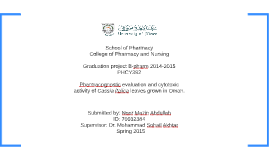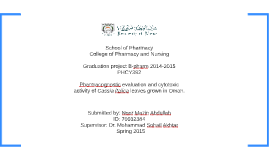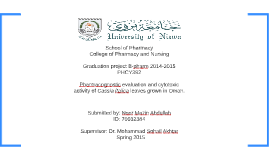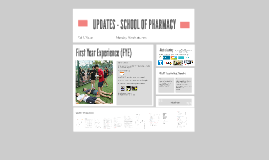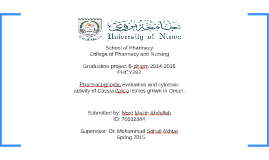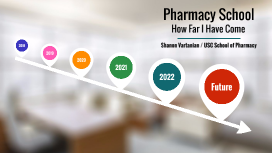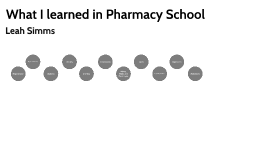School of Pharmacy
Transcript: Antimicrobial Microscopy of leaves powder: CHEMICAL CONSTITUENTS REPORTED Preliminary Phytochemical Screening * Powder have been soaked with Ethanol (24 x3). * Filtered under vacuum by Buchner apparatus. * Evaporated at low pressure using rotary evaporator. Hypoglycemic Prof. Ahmed Al-Rawahi Chancellor, University of Nizwa. Stock solution Objectives COLLECTION OF THE PLANT and to all my teachers and laboratory technicians.. * Compound microscope was used. * Slides have been prepared with fresh powder. * Slides have been observed in different magnification powers (4x - 40x power). Results and Discussion Brine shrimp lethality test 1ml of stock solution + 9ml of DCM Prof. Nafsiah Binti Shamsudin Dean of the College of Nursing & Pharmacy. Preparing crude extracts of different organic solvents Flavonoids 9. Ahangarpour A, Akbar Oroojan A, The effects of Cassia italica leaves aqueous extract on non-pregnant uterus contraction in rats, Iranian Journal of Reproductive Medicine, 2010, 8: 179-180. 10. Sermakkani M, Thangapandian V. GC-MS Analysis of Cassia Italica leaf methanol extract, Asian Journal of Pharmaceutical and Clinical Research, 2012, (5), 2: 92-93. 11. Modibbo AA, Nadro MS. Hepatoprotetive Effects of Cassia Italica Leaf Extracts on Carbon Tetrachloride-induced Jaundice, Asian Journal of Biochemical and Pharmaceutical Research, 2012, (2) 2: 382. 12. Balasankar D, Vanilarasu K, Selva P, Preeth, .Rajeswari , M.Umadevi M, Bhowmik D. Senna – A Medical Miracle Plant, Journal of Medicinal Plants Studies (2013), Volume (1),3: 43. 13. Ahmed M, Fatin A, Emad S, Hany E. Potent Anticancer and Antioxidant Activities of Active Ingredients Separated from Solanum nigrum and Cassia italica Extracts. Journal of Arid Land Studies, 2014, 1 : 147-149. 14. Agarwal V, Bajpai M, Pharmacognostical and biological studies on Senna and its products, International Journal of Pharma and Bio Sciences, 2010, 2, : 8 15. Balasankar D, Vanilarasu K, Selva P, Preeth, Rajeswari S, Umadevi M, Bhowmik D. Senna – A Medical Miracle Plant, Journal of Medicinal Plants Studies (2013), Volume 1, 3, : 41-43. 16. Parekh J, Chand S. Phytochemical screening of some plants from Western regions of India. Plant Arch, 2008; 8: 657 – 662. 17. Harborne J B. Methods of plant analysis. Phytochemical Methods. London; Chapman and Hall, 1973, pp. 176-183. 18. Mclaughlin JL, Rogers LL, Anderson JE. The use of Biological Assay to Evaluate Botanicals, Drug Info. Journal 1998, 32; 513-524. 19. (USEPA) U.S. Environmental Protection Agency. 1994. EPA Probit analysis program. Calculating LC/EC values Version 1.5. (http://www.epa.gov/nerleerd/stat2.htm). 20. Bravo L. Polyphenols: Chemistry, dietary sources, metabolism and nutritional significance. Nutr.Rev., 1998; 56: 317-333. Re-extraction * It is a small shrub which grows up to 3 feet. * Oblong shaped pods or fruit cases. * Flowers are yellowish in color and asymmetric. * Leaves are obovate, smooth, opposite and rounded in shape. Collection of plant leaves and make the powder form Revealed the presence of four chemical constituents: Crude organic extract from Cassia italica leaves Dr. Mohammed Sohail Akhtar Assistant Dean (Research). 1- Four structures of Cassia italica leaves have been identified under the microscope: Paracytic stomata. Bent trichomes. Pitted vessel. Groups of fibers with calcium oxalate. 2- Preliminary phytochemical screening indicated the presence of: Alkaloids. Anthraquinone glycosides. Flavonoids. Phenols. School of Pharmacy College of Pharmacy and Nursing Graduation project B-pharm 2014-2015 PHCY382 Pharmacognostic evaluation and cytotoxic activity of Cassia italica leaves grown in Oman. So, Middle polar and polar extracts are more active against the brine shrimp larvae. Flavonoids - Amount of crude extracts obtained from Cassia italica leaves after 72 hours of the maceration in ethanol was 7.45 g. - The amount of fractionated extracts is listed in the table below. Different qualitative tests have been done to detect the presence of different plant secondary metabolites in Ethanolic extract of Cassia italica leaves. 125mcg/ml MORPHOLOGY Preliminary phytochemical screening Thank you Brine Shrimp Test Microscopy of leaves powder 1- Alkaloids. 2- Anthraquinone glycosides. 3- Flavonoids. 4- Phenols. 5- Saponins. 6- Tannins. 10mg/ml - Cassia italica is a wild distributed plant in tropical regions of the world, deserts and semi deserts. - In Oman, it could be found in many regions (Dhofar, Muscat, Al-Sharqiya and Al-Dakhliya) - Locally known as (Holoul) Dr. Shyam Sundar Acting Associate Dean & Assistant Dean. - Crude extract was re-dissolved in (ethanol:distilled water 1:1 mixture). - Re-extracted with Petroleum ether (50ml x 2) and chloroform (50ml x 2) By Separating funnel. - Solvents were removed using rotary evaporator. - Petroleum ether, Chloroform and Hydro-Alcoholic extracts. 1. G.H. Schmelzer, A. Gurib-Fakim, Plant resources of Tropical Africa. Medicinal plants 1, Ed. 11, Pg.509. 2. Al-Saady






